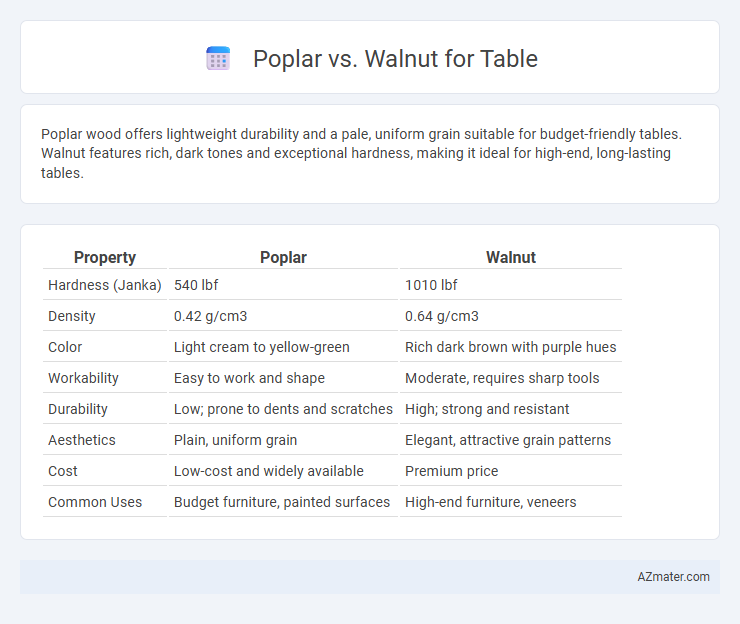Poplar wood offers lightweight durability and a pale, uniform grain suitable for budget-friendly tables. Walnut features rich, dark tones and exceptional hardness, making it ideal for high-end, long-lasting tables.
Table of Comparison
| Property | Poplar | Walnut |
|---|---|---|
| Hardness (Janka) | 540 lbf | 1010 lbf |
| Density | 0.42 g/cm3 | 0.64 g/cm3 |
| Color | Light cream to yellow-green | Rich dark brown with purple hues |
| Workability | Easy to work and shape | Moderate, requires sharp tools |
| Durability | Low; prone to dents and scratches | High; strong and resistant |
| Aesthetics | Plain, uniform grain | Elegant, attractive grain patterns |
| Cost | Low-cost and widely available | Premium price |
| Common Uses | Budget furniture, painted surfaces | High-end furniture, veneers |
Introduction to Poplar and Walnut for Tables
Poplar is a lightweight, affordable hardwood commonly used for crafting tables due to its fine, uniform grain and pale color, making it easy to paint or stain. Walnut, prized for its rich, dark brown hue and durability, offers a luxurious finish ideal for high-end tables requiring strength and natural beauty. Both woods vary significantly in hardness and aesthetic appeal, influencing their suitability for different table styles and budgets.
Poplar Wood Characteristics
Poplar wood is lightweight and moderately soft, making it easy to work with using common woodworking tools. It features a straight grain with a fine, even texture, and typically has a pale yellowish to light green color that can be easily stained to mimic more expensive woods like walnut. Its stability and affordability make poplar a practical choice for table projects where durability and cost-efficiency are key considerations.
Walnut Wood Characteristics
Walnut wood is highly valued for its rich, dark brown color with a fine, straight grain that enhances the aesthetic appeal of tables. Its density and hardness make it durable and resistant to wear, ideal for long-lasting furniture surfaces. Compared to poplar, walnut offers superior strength and a luxurious finish, making it a preferred choice for high-end table construction.
Appearance and Color Comparison
Poplar wood typically features a pale creamy white to light yellow color with subtle green or gray hues, offering a smooth and uniform grain pattern ideal for painting or staining. Walnut exhibits a rich, dark brown to purplish-black color with striking, complex grain patterns that range from straight to wavy, providing a luxurious and elegant appearance. The visual contrast between Poplar's lighter, more neutral tones and Walnut's deep, warm coloration makes each suited for distinct aesthetic preferences in table design.
Durability and Strength Differences
Poplar is a soft hardwood with moderate durability, making it less resistant to dents and scratches compared to walnut, which is a dense and hard wood known for its exceptional strength and long-lasting durability. Walnut's higher Janka hardness rating of approximately 1,010 lbf surpasses poplar's 540 lbf, indicating greater resistance to wear and impact for tables. Choosing walnut ensures a sturdy, durable surface ideal for heavy daily use, while poplar suits lighter, decorative applications where cost efficiency is prioritized.
Workability and Ease of Crafting
Poplar wood offers superior workability for table crafting due to its soft texture and low density, allowing for easy cutting, sanding, and shaping with hand or power tools. Walnut, while denser and harder, provides excellent machinability but requires sharper tools and more effort to carve intricate details. Both woods accept finishes well, but Poplar is favored for quick projects and detailed work, whereas Walnut excels in durable, high-end furniture with fine craftsmanship.
Cost and Availability
Poplar is a budget-friendly wood choice for tables, commonly priced lower than walnut due to its faster growth and wider availability. Walnut, known for its rich color and durability, tends to be more expensive and less abundant, making it a premium option for high-end furniture. Both woods are widely available in North American markets, but poplar's affordability and ease of sourcing often make it the preferred material for cost-conscious projects.
Environmental Impact and Sustainability
Poplar wood's rapid growth and widespread availability contribute to its lower environmental impact compared to slower-growing Walnut, which often requires more intensive forestry management. Poplar plantations typically promote carbon sequestration and reduce deforestation pressures, whereas Walnut's harvesting can lead to habitat disruption due to selective logging practices. Choosing Poplar for tables supports sustainability by minimizing resource depletion and encouraging responsible wood sourcing, making it an eco-friendlier option than Walnut.
Best Uses of Poplar vs Walnut Tables
Poplar tables are best suited for painted finishes and affordable furniture due to their smooth grain and lightweight properties, making them ideal for casual dining or craft tables. Walnut tables, prized for their rich color and durability, excel in high-end, heirloom-quality furniture and executive desks where elegance and longevity are essential. Poplar's cost-effectiveness contrasts with walnut's premium status, guiding choices based on budget and desired aesthetic impact.
Choosing the Right Wood for Your Table
Poplar offers a lightweight, budget-friendly option with a smooth grain ideal for painted or stained finishes, making it suitable for casual table designs. Walnut provides a rich, dark hue and natural durability, often chosen for high-end tables where aesthetic appeal and strength are priorities. Selecting between poplar and walnut depends on your preference for cost, appearance, and the table's intended use and longevity.

Infographic: Poplar vs Walnut for Table
 azmater.com
azmater.com